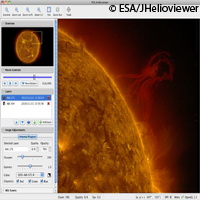ESA offers the Sun to the world
The European Space Agency (ESA) has developed innovative software that makes it easy for people, regardless if they are experts or not, to access the entire library of images from the Solar and Heliospheric Observatory (SOHO) with a click of a mouse. The 'JHelioviewer' is ESA's state-of-the-art visualisation software that gives people 'direct' access to the Sun. ESA scientists worked together with NASA experts to make this software possible. Developed as part of the ESA/NASA Helioviewer Project, which seeks to design systems and services that enable users worldwide to explore the Sun and inner heliosphere as well as to provide transparent access to the underlying data, JHelioviewer allows users to retrieve images from the Sun from as early as 15 years ago. According to the project partners, access to more than 1 million images from SOHO is now possible. New images from NASA's Solar Dynamics Observatory are added on a daily basis, they said. The web-based image browser Helioviewer.org complements the downloadable JHelioviewer. The experts say this new software allows users to do so many creative things, including creating their own movies of the Sun, exporting their finished movies in different formats and tracking features of the Sun by compensating for solar rotation. They can also colour the images in any way they wish, and image-process the movies in real time. 'We wanted to make it easy to view solar images from different observatories and instruments, and to make it easy to make movies,' explained Daniel Müller, ESA SOHO deputy project scientist. 'Before, it took hours to combine images from different telescopes to make a movie of the Sun for a given period. With JHelioviewer, everyone can do this in minutes. This is an interactive visual archive of the entire SOHO mission.' The ESA team pointed out that JHelioviewer is written in the Java programming language, which is why they inserted the 'J' at the start of its name. The beauty of this software is that it is open source, making all of its components free to the public. This allows users to improve the programme. But that is not all. According to the team, the code can be reused for other purposes as well, namely for medical research and even for Mars data. This advantage is due to the fact that the JHelioviewer does not need to download entire datasets, which are typically quite extensive, but it can select enough data to stream over the Internet without much fuss. The data can also be annotated, such as marking solar flares of specific magnitude or highlighting diseased tissues in medical images. 'The goal of JHelioviewer, and the Helioviewer Project as a whole, is to offer intuitive interfaces to large datasets from many different sources. In effect, it is a virtual observatory,' Dr Müller said.For more information, please visit:European Space Agency (ESA):http://www.esa.int/esaCP/index.htmlJHelioviewer:http://jhelioviewer.org/



